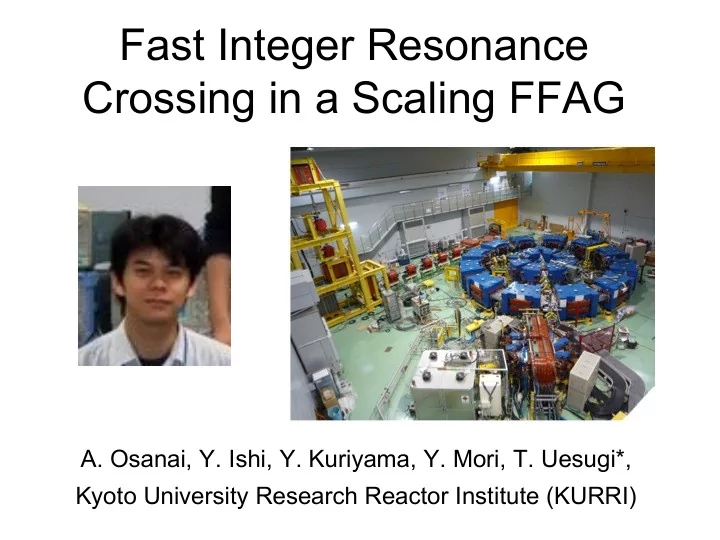

Fast Integer Resonance Crossing in a Scaling FFAG A. Osanai, Y. Ishi, Y. Kuriyama, Y. Mori, T. Uesugi*, Kyoto University Research Reactor Institute (KURRI)
Purpose To verify experimentally Integer resonance can be crossed, when the crossing speed is high enough.
Injector FFAG in KURRI
• Variable k, by means of 32 trim-coils --> Hori. tune is controllable --> easy to demonstrate resonance crossing • Induction acceleration --> No longitudinal focus, --> no energy oscillation, which affects the horizontal betatron oscillations
Tune Variation Without exciting trim-coils, Qx~~1, but depending on E Simulation based on TOSCA field (Crossing speed) = 0.0024/kev * (Accel. Voltage) < 0.0084/turn
First Harmonic Force was applied by ‘Error field clamps’ which has wider gap than the others. TOSCA * Effects of accelerations at two gaps work in counter-phase when Qx=~ 1.
Observing Coherent Oscillations Elapsed time was measured at different radius then …..
What is expected
What is expected Coherent oscillations will be observed
Experimental Results A part of beam survived after resonance crossing ! 1000pA @ R=920mm Finite amplitude of betatron oscillations was observed. The curve shows simulation results with fitting Initial condition (amplitude and phase).
Dependence on Crossing speed FAST SLOW No difference in the final amplitude ? It’s possible because …..
Final Amplitude depends on Initial Conditions General Solution Solutions of homogeneous eq.; A solution of inhomogeneous eq.; Oscillating in freq ν, Oscillating in freq ν, Little resonant blow up, Big resonant blow up Initial amplitude, phase .. If this part is not negligible Phase difference ? . In phase --> Maximum amplitude growth |S|+|A| . Counter phase --> Minimum growth |S|-|A|
Maximum Amplitude Growth (Simulation) Worst cases of simulations with different initial phase • simul. (single kick approx. of driving force) - model (field err) / sqrt(crossing speed)
Summary • Fast crossing of Qx=1 resonance has been examined in Injector FFAG of KURRI. • The beam survived after the crossing, because of the fast tune variation (and large horizontal acceptance). • The measured oscillation was reproduced by Runge-Kutta simulations. • Simulated amplitude growth was proportional to 1/sqrt(dQ/dt)
Recommend
More recommend